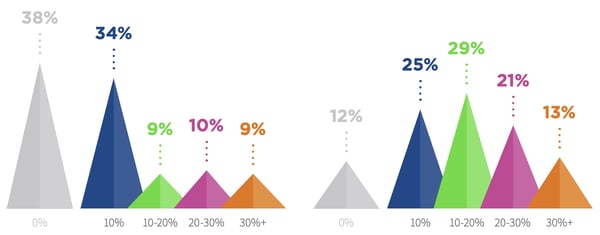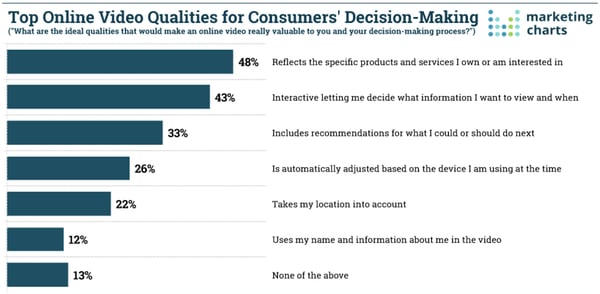In December 2018, Netflix viewers were introduced to the platform's first interactive film, Black Mirror: Bandersnatch.
Bandersnatch followed a character named Stefan, a tormented game developer who was forced to make a number of simple and tough decisions to release a video game.
Each time Stefan had to make a decision -- such as eating Sugar Puffs or Frosties for breakfast -- two options would appear on the screen. Stefan's fate was then in the Netflix viewers' hands as they could choose what happened next.
The choose-your-own-adventure film -- which allowed viewers to go down one of nearly one trillion paths based on their choices -- was a viral hit.
Bandersnatch generated a ton of buzz on social media for Netflix, and the streaming giant was also able to use data from the decisions viewers selected. At one point, the streaming site released data to show which choices users commonly made.
Since Bandersnatch's success, the entertainment industry and brands have continued to jump on the interactive content bandwagon with high-priced AR/VR and even video-game based campaigns.
But, as a small or medium-sized business marketer who isn't ready to dabble in AR/VR just yet, you might be wondering, "Is interactive content really worth its price?"
Yes, interactive content is highly engaging, attracts customers, and provides value. But, you don't necessarily need expertise in emerging technology to leverage it.
Below are 21 stats that highlight how interactive content is growing, the benefits it provides for brands, emerging interactive marketing technology, and a few of the most effective content types that marketers are using today.
21 Interactive Content Stats to Know
General Interactive Content Stats
- 45% of B2B buyers say interactive content is one of their top three preferred content types. (SnapApp)
- 51% of B2B buyers say interactive content is helpful when tackling business challenges. (SnapApp)
- 62% of B2B marketers are already using interactive content. (DemandGen)
- Interactive content gains two times more engagement than static content. (DemandGen)
- 34% of marketers say at least 10% of their content is interactive. (DemandGen)
- Meanwhile, 88% of marketers say at least 10% of their static content will be made interactive in the next two years. (DemandGen)

- 77% of marketers agree that interactive content has "reusable" value, resulting in repeat visitors and multiple exposures. (Content Marketing Institute)
- 73% agree that combining traditional content marketing tactics with interactive content enhances the retention of their organization’s message. (Content Marketing Institute)
Interactive Content Types
Quizzes, Polls, and Interactive Infographics
- 85% of B2B marketers are already using or plan to use interactive infographics as part of their strategy. (DemandGen)
- Women.com owns well over half the engagement for online quizzes, dominating even Buzzfeed, which is better known for this kind of interactive content. (Buzzsumo)
- 75% agree that non-gated interactive content can provide a “sample” of the brand, resulting in a higher degree of lead nurturing. (Content Marketing Institute)
- In a HubSpot poll, 15% of consumers preferred to tap through Instagram Stories with quiz or poll features. This interactive content type was the third most popular Story format. (HubSpot)
Interactive Videos, AR, and VR
- 62% of B2B marketers plan to use or are already using interactive videos in their tactics. (DemandGen)
- 43% of consumers prefer interactive video content over other types of video content because it gives them the ability to decide what information they want to view and when they want to view it. (MarketingCharts)

- 38% of agency experts say they help produce webinars for clients. (Content Marketing Institute)
- 45% of agency employees help brands create live experiences, such as virtual events or Q&As. (Content Marketing Institute)
- In 2019, 42.9 million people in the US used a VR product, and 68.7 million people used an AR once monthly. (eMarketer)
- In 2018, 88% of companies with budgets between $100 million and $1 billion were already experimenting with different forms of AR. (Deloitte)
- A quarter of VR users believe it has a strong potential for brands and marketers. (GlobalWebIndex)
- 71% of consumers would prefer to shop at stores with an AR experience (Lumus Vision)
- 64% of consumers say VR has the most potential in gaming, while 52% recognize its potential in Film and TV. (GlobalWebIndex)
Testing the Waters With Interactive Content
If you're primarily used to creating static content, wrapping your mind around how to make your branding more interactive can feel overwhelming.
Luckily, in 2020, you don't need to be an AR expert or a coder to test the waters with low-cost interactive content. For example, you could leverage Instagram or Facebook Stories to poll or quiz your audiences, use an online quiz creator to generate an assessment for your website, or plan a live stream on a social platform that allows you to ask an expert questions from those who are commenting on it.
For a few great examples of how brands are getting interactive, check out this blog post. Ready to get started with your own content? Here are a few easy-to-use tools that can help you.
No comments:
Post a Comment